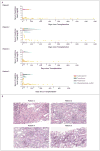HLA-mismatched renal transplantation without maintenance immunosuppression
- PMID: 18216355
- PMCID: PMC2819046
- DOI: 10.1056/NEJMoa071074
HLA-mismatched renal transplantation without maintenance immunosuppression
Abstract
Five patients with end-stage renal disease received combined bone marrow and kidney transplants from HLA single-haplotype mismatched living related donors, with the use of a nonmyeloablative preparative regimen. Transient chimerism and reversible capillary leak syndrome developed in all recipients. Irreversible humoral rejection occurred in one patient. In the other four recipients, it was possible to discontinue all immunosuppressive therapy 9 to 14 months after the transplantation, and renal function has remained stable for 2.0 to 5.3 years since transplantation. The T cells from these four recipients, tested in vitro, showed donor-specific unresponsiveness and in specimens from allograft biopsies, obtained after withdrawal of immunosuppressive therapy, there were high levels of P3 (FOXP3) messenger RNA (mRNA) but not granzyme B mRNA.
Copyright 2008 Massachusetts Medical Society.
Conflict of interest statement
No potential conflict of interest relevant to this article was reported.
Figures


Comment in
-
Immunosuppressive therapy and tolerance of organ allografts.N Engl J Med. 2008 Jan 24;358(4):407-11. doi: 10.1056/NEJMe0707578. N Engl J Med. 2008. PMID: 18216363 Free PMC article. No abstract available.
References
-
- Pascual M, Theruvath T, Kawai T, Tolkoff-Rubin N, Cosimi AB. Strategies to improve long-term outcomes after renal transplantation. N Engl J Med. 2002;346:580–90. - PubMed
-
- Sayegh MH, Carpenter CB. Transplantation 50 years later — progress, challenges, and promises. N Engl J Med. 2004;351:2761–6. - PubMed
-
- Murray JE, Merrill JP, Dammin GJ, et al. Study on transplantation immunity after total body irradiation: clinical and experimental investigation. Surgery. 1960;48:272–84. - PubMed
-
- Barber WH, Mankin JA, Laskow DA, et al. Long-term results of a controlled prospective study with transfusion of donor-specific bone marrow in 57 cadaveric renal allograft recipients. Transplantation. 1991;51:70–5. - PubMed
-
- Millan MT, Shizuru JA, Hoffmann P, et al. Mixed chimerism and immunosuppressive drug withdrawal after HLA-mismatched kidney and hematopoietic progenitor transplantation. Transplantation. 2002;73:1386–91. - PubMed
Publication types
MeSH terms
Substances
Grants and funding
LinkOut - more resources
Full Text Sources
Other Literature Sources
Medical
Research Materials
